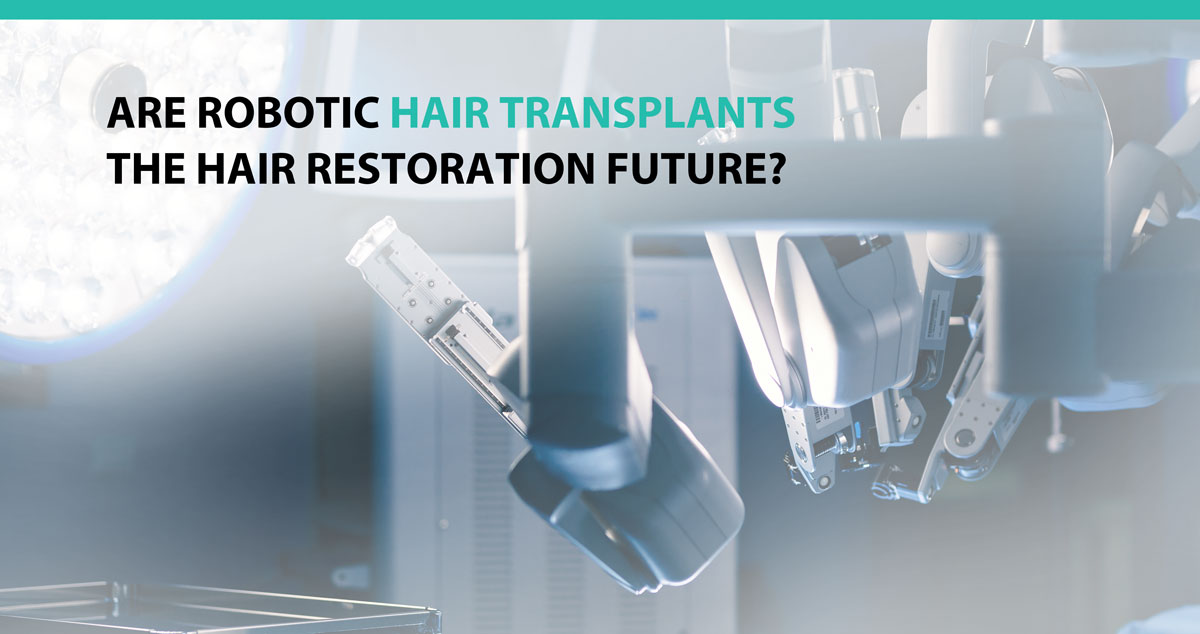
With a large percentage of both men and women suffering from hair loss, it’s no wonder we’re contemplating the hair restoration future. What new ideas are on the horizon? Will hair loss in women be better understood? Will we be able to bypass male pattern baldness altogether? What is the future of hair restoration? For those currently dealing with hair loss – or know hair loss is in their future – these are important questions to answer.
So, what exactly is in store for us when it comes to what to expect? Many are excited about robotic hair transplants but are they currently positioned to become the future of hair restoration? Let’s dive in.
What is a robotic hair transplant?
A robotic hair transplant is a hair restoration procedure in which hair is removed from the patient and then transplanted to a balding area using a robotically-control arm.
Think of it like a robotic arm-assisted surgical procedure. Sounds fancy, right? Before you run to find a robotic hair transplant provider, there are some important things to be aware of.
Is everyone a candidate for a robotic hair transplant?
When you’re evaluating the potential for a procedure to be the future of an industry, a great place to start is patient candidacy. So, is everyone a candidate for a robotic hair transplant? Unfortunately, no, and the technology has a long way to go before it can be considered as a serious contender as the future of hair restoration.
As it currently stands, the only patients who are good candidates for a robotic hair transplant are those with dark, straight hair. If you have light-colored hair or curly locks, you’re out of luck.
It’s also believed that because the cause of genetic hair loss in women isn’t completely understood, women may not be the best candidates for this type of hair restoration procedure either.
Furthermore, if you have a poor donor site or your hair loss is attributed to stress, medication, or some other reversible cause, you’re also not a candidate. That means a very slim percentage of those suffering from hair loss can utilize this technology. Not a great start when you’re talking about the future of an industry.
Is this procedure FDA-approved?
What’s a bit of good news when it comes to robotic hair transplants? There is an FDA-approved option…sort of!
Because of its candidacy drawbacks, a certain type of machine has been FDA-approved, but only for men with straight, dark hair. Again, the technology will need to go a lot further if we’re to rely on this type of hair restoration procedure in the future.
How much does a robotic hair transplant cost?
Like any new technology fad that isn’t readily available, those looking to do this type of procedure need to be prepared to pay a hefty sum.
National averages for a traditional restoration procedure, like the ones performed here at our Las Vegas hair transplant center, tend to start at just $4 per graft while those interested in a robotic hair transplant may see upwards of $15 per graft.
While procedure costs vary greatly from patient to patient, traditional hair restoration surgeries run anywhere from $4,000 to $15,000, while comparable robotic options generally fall between $7,000 to $18,000. If cost is a factor, which it is for many, robotic hair transplants may not be the most cost-effective way to go.
Main drawbacks of robotic hair transplants
So, what are the main drawbacks of robotic hair transplants that need to be considered when evaluating this procedure’s potential to be the future of hair restoration? The following:
- Very few people are good candidates
- Robotic hair transplants can only extract from limited areas
- High cost
Are robotic hair transplants the future of hair restoration?
As you can see, robotic hair transplants still have a long way to go before they can be considered the best hair loss solution available.
What does a published review of robotic hair transplants have to say on the matter? “Robotic hair transplantation is an important tool for hair transplant surgeons, but does not replace appropriate candidate selection, hairline design, and the judgment of where to place and not place transplanted hair for optimal short- and long-term results.”
Don’t wait for years in the hopes that this technology will be perfected, and that you’ll be a good candidate; contact Advanced Medical Hair Institute for a consultation today. Our experienced team will review the best hair transplant surgery options available to you after uncovering the reason behind the loss.
When it comes to a variety of candidates, all of whom are looking for a full head of healthy hair, our Las Vegas hair restoration center can’t be beat! Stop hair loss in its tracks – get in touch with our Las Vegas or Reno, Nevada location today.










